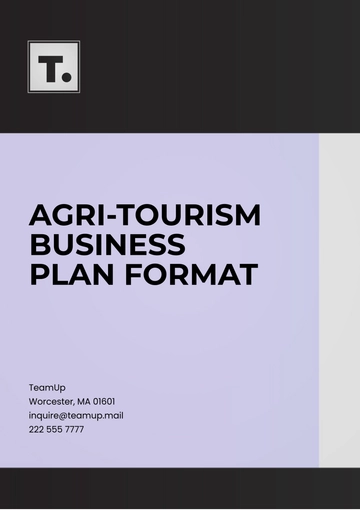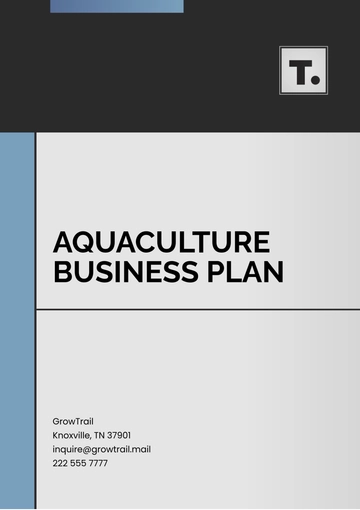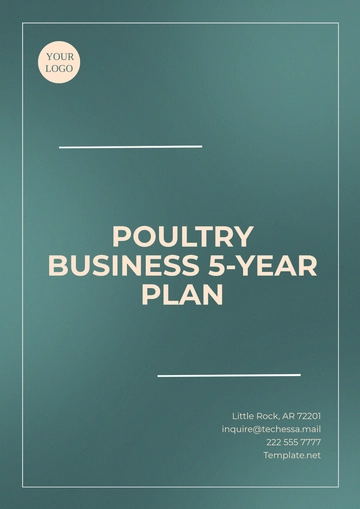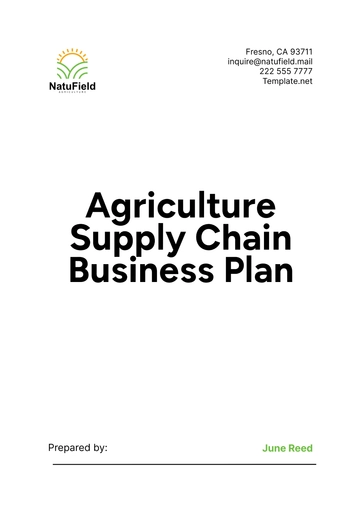Free Crop Production Business Plan

Prepared By: [YOUR NAME]
Date: [DATE]
1. Executive Summary
Business Name: [Your Company Name]
Location: [Insert Location]
Business Structure: Limited Liability Company (LLC)
A. Business Overview:
[Your Company Name] aims to establish a sustainable and profitable crop farming business in [Region/Area]. We aim to provide high-quality, locally-grown produce for consumers and regional suppliers. We will begin by growing corn, soybeans, and leafy greens, with plans for crop diversification in future seasons to meet evolving market demand.
B. Vision Statement:
To become a leading crop production farm in [Region/Area] by consistently delivering nutritious and high-quality crops using sustainable farming practices.
C. Objectives:
Achieve a 15% profit margin in the first year.
Secure contracts with at least three major regional distributors.
Develop a recognized brand for quality and sustainability within two years.
2. Business Description
A. Business Model:
[Your Company Name] will operate on a direct-to-market and wholesale model, providing produce to grocery stores, farmers' markets, and wholesale distributors.
B. Unique Selling Proposition (USP):
[Your Company Name] focuses on sustainable, eco-friendly practices, producing high-quality, organic-certified crops. Our brand emphasizes locally sourced, fresh produce to meet the growing demand for healthier and traceable food options.
C. Goals:
Build a strong brand presence within the local market.
Expand the farm’s acreage within three years.
Implement and maintain sustainable farming practices to minimize environmental impact.
3. Market Analysis
A. Industry Overview:
The demand for fresh, local produce is steadily rising as consumers increasingly prioritize health, wellness, and environmental sustainability. Locally grown crops have a strong market due to lower transportation costs, fresher quality, and their ability to meet rising consumer demand for sustainable food.
B. Target Market
[Your Company Name] will target grocery chains, farm-to-table restaurants, and regional farmers' markets in [Region/Area]. Additionally, we will focus on establishing relationships with health-conscious and organic food stores.
C. Market Trends:
Rising consumer preference for organic and locally grown produce.
Increased interest in sustainable farming practices and eco-friendly sourcing.
Government incentives and grants supporting small-scale agriculture.
D. Competitive Analysis:
Our competitors include other small-to-medium local farms and larger commercial farms. [Your Company Name] stands out by focusing on organic certification, sustainable practices, and deep-rooted community involvement.
4. Products and Services
A. Primary Crops:
Corn
Soybeans
Leafy Greens (lettuce, spinach, kale)
B. Future Plans:
To diversify by adding tomatoes, carrots, bell peppers, and sweet potatoes in subsequent seasons as demand grows.
C. Production Process:
[Your Company Name] will implement a crop rotation schedule with organic pest management techniques focused on soil health and yield maximization. We will use drip irrigation and mulching to optimize water use and reduce weed growth.
D. Service Offerings:
In addition to fresh produce, [Your Company Name] will offer value-added services such as farm tours, educational sessions on sustainable farming, and participation in local farmers' markets.
5. Marketing and Sales Strategy
A. Marketing Objectives:
Establish a recognizable brand emphasizing sustainability and locally sourced produce.
Secure wholesale partnerships with at least three regional grocery chains.
Participate in farmers' markets, local events, and agricultural trade shows.
B. Sales Strategy:
Direct-to-consumer sales through farmers' markets and local community events.
Wholesale contracts with grocery stores and local distributors.
Strategic partnerships with restaurants focused on organic and locally sourced ingredients.
C. Promotional Strategies:
Maintain an online presence through a website and social media platforms to engage with local consumers.
Send out seasonal newsletters and crop availability updates to our subscribers.
Advertise at local events and offer sponsorships to increase brand visibility.
6. Operational Plan
A. Location and Facilities:
[Your Company Name] will operate on 50 acres of farmland located in [Region/Area], equipped with access to irrigation, quality soil, and nearby transportation routes to facilitate distribution.
B. Production Timeline:
January-February: Land preparation, planting schedule planning.
March-May: Planting of spring crops.
June-August: Maintenance and harvest of summer crops.
September-November: Harvest of fall crops and winter land prep.
C. Equipment Needed:
Tractors
Drip irrigation system
Greenhouse structures (for seedlings and early starts)
Harvesting and packaging machinery
D. Personnel Requirements:
Farm Manager (1)
Seasonal Farm Workers (5-10)
Marketing and Sales Coordinator (1)
C. Supply Chain Management:
We will source seeds, organic fertilizers, and other inputs from local suppliers known for quality and sustainable practices, building a supply chain focused on sustainability and resilience.
7. Financial Plan
A. Startup Costs:
Land Lease and Initial Setup: $50,000
Equipment and Machinery: $75,000
Seeds, Fertilizers, and Supplies: $20,000
Marketing and Branding: $10,000
Working Capital: $25,000
B. Revenue Projections:
Year 1: $150,000
Year 2: $200,000
Year 3: $275,000
C. Expense Projections:
Year 1: $120,000
Year 2: $140,000
Year 3: $160,000
C. Funding Needs:
[Your Company Name] seeks an initial investment of $150,000 to cover startup costs, with anticipated revenue enabling payback within five years.
D. Break-even Analysis:
[Your Company Name]'s break-even point is projected within 18 months, assuming stable crop yields and successful market penetration.
8. Risk Analysis
A. Potential Risks:
Climate and weather variability affecting crop yields.
Price fluctuations in the agricultural market.
Pests or diseases impacting crop health.
B. Risk Mitigation Strategies:
Obtain crop insurance to safeguard against extreme weather and crop failure.
Utilize crop rotation and pest management strategies.
Maintain a reserve fund to manage cash flow during low-yield periods.
9. Appendix
Sample Crop Rotation Schedule
Detailed Revenue and Expense Projections
Marketing Materials (logos, website designs)
- 100% Customizable, free editor
- Access 1 Million+ Templates, photo’s & graphics
- Download or share as a template
- Click and replace photos, graphics, text, backgrounds
- Resize, crop, AI write & more
- Access advanced editor
You may also like
- One Page Business Plan
- Coffee Shop Business Plan
- Restaurant Business Plan
- Food Business Plan
- Real Estate Business Plan
- Executive Summary Business Plan
- Cover Page Business Plan
- Nonprofit Business Plan
- Daycare Business Plan
- Construction Business Plan
- Startup Business Plan
- Medical Business Plan
- Bakery Business Plan
- Service Plan
- Hotel Business Plan
- Catering Business Plan
- School Business Plan
- Healthcare Business Plan
- Transportation Plan
- Sports Plan
- Car Wash Business Plan
- Salon Business Plan
- Clothing Business Plan
- Farming Business Plan
- Boutique Plan





























